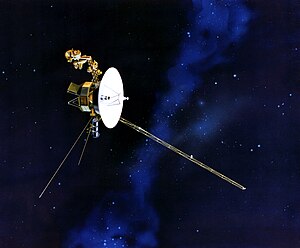Voyager 1

Voyager 1, artist's impression
|
|
| Mission type | Outer planetary, heliosphere, and interstellar medium exploration |
|---|---|
| Operator | NASA / JPL |
| COSPAR ID | 1977-084A |
| SATCAT № | 10321 |
| Website | voyager |
| Mission duration | 39 years, 5 months and 8 days elapsed Planetary mission: 3 years, 3 months, 9 days Interstellar mission: 36 years, 1 month and 30 days elapsed (continuing) |
| Spacecraft properties | |
| Manufacturer | Jet Propulsion Laboratory |
| Launch mass | 825.5 kg (1,820 lb) |
| Power | 420 watts |
| Start of mission | |
| Launch date | September 5, 1977, 12:56:00 UTC (39 years, 5 months and 8 days) |
| Rocket | Titan IIIE |
| Launch site | Cape Canaveral LC-41 |
| Flyby of Jupiter | |
| Closest approach | March 5, 1979 |
| Distance | 349,000 km (217,000 mi) |
| Flyby of Saturn | |
| Closest approach | November 12, 1980 |
| Distance | 124,000 km (77,000 mi) |
| Flyby of Titan (Atmosphere study) | |
| Closest approach | November 12, 1980 |
| Distance | 6,490 km (4,030 mi) |
Voyager 1 is a space probe launched by NASA on September 5, 1977. Part of the Voyager program to study the outer Solar System, Voyager 1 launched 16 days after its twin, Voyager 2. Having operated for 39 years, 5 months and 8 days, the spacecraft still communicates with the Deep Space Network to receive routine commands and return data. At a distance of 137 AU (2.05×1010 km) from the Sun as of December 2016, it is the farthest spacecraft from Earth as well as the farthest man-made object.
The probe's primary mission objectives included flybys of Jupiter, Saturn, and Saturn's large moon, Titan. While the spacecraft's course could have been altered to include a Pluto encounter by forgoing the Titan flyby, exploration of the moon, which was known to have a substantial atmosphere, took priority. It studied the weather, magnetic fields, and rings of the two planets and was the first probe to provide detailed images of their moons.
After completing its primary mission with the flyby of Saturn on November 20, 1980, Voyager 1 began an extended mission to explore the regions and boundaries of the outer heliosphere. On August 25, 2012, Voyager 1 crossed the heliopause to become the first spacecraft to enter interstellar space and study the interstellar medium.Voyager 1's extended mission is expected to continue until around 2025, when its radioisotope thermoelectric generators will no longer supply enough electric power to operate any of its scientific instruments.
In the 1960s, a Grand Tour to study the outer planets was proposed which prompted NASA to begin work on a mission in the early 1970s. Information gathered by the Pioneer 10 spacecraft helped Voyager's engineers design Voyager to cope more effectively with the intense radiation environment around Jupiter.
...
Wikipedia
